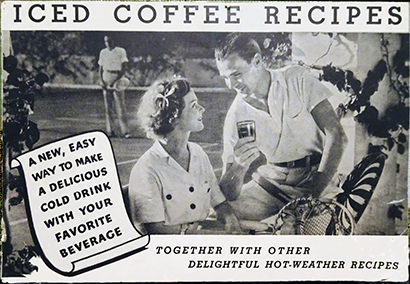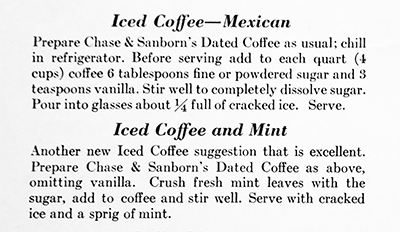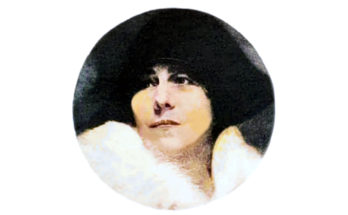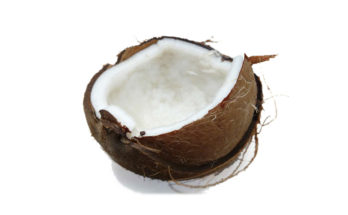
Chase & Sanborn’s Teas & Coffees, founded in 1878, was by 1892 called “Seal Brand” using the Chase family seal and Latin inscription, Ne cede malis. Do not yield to evil.
After Standard Brands purchased Chase & Sanborn in 1929, keeping the Seal Brand, they renamed the coffee product, Chase & Sanborn’s Dated Coffee.

And what was Dated Coffee? The date the coffee was received by the retail store was printed in large type on coffee labels [see cans on eBay link, no affiliation] Dated Coffee was packaged “fresh from the roasting ovens” and delivered to stores twice per week. If the coffee was in the store 10 days after the date on the can, it was exchanged for fresh cans.
Snafus in Early Print Advertising for Dated Coffee
Before Standard Brands, Chase & Sanborn relied on a massive sales force, great distribution, and goodwill. For print they had booklets about the American Flag, and Tricks and Puzzles for after dinner amusement, and other general booklets with just the covers mentioning Chase & Sanborn. There were also ink blotters with colorful advertisements. Nothing earth-shaking.
After the Standard Brand purchase, magazine and newspapers ran jazzier full page ads, although I believe their wording was a bit rocky at the beginning: No problem with the 1930 ad that just stated that Dated Coffee was “Direct from the roasting ovens… no storage stop overs…weeks fresher…” The term “weeks fresher” could pose a problem later. The 1931 magazine advertisements stated, “The development of rancidity in coffee is a matter of days, not months…” Even if it was “dated” and Chase & Sanborn Dated Coffee was the freshest roasted coffee in the marketplace, coffee becoming rancid after “a matter of days” would worry anyone. The Dated cans held one pound of coffee. A peak under the top cover in a 1932 ad we see the coffee was ground. How many cups of coffee, or days, does it take to consume one pound of ground coffee? For drip coffee it is about 30 cups [2 adults, 2 cups/day, 1 week?], percolated coffee reaps about 100 cups. The company recommended drinking up to 5 cups of coffee per day–perhaps that helped to use up the can quicker before getting stale “in a matter of days.”
The 1931 “in a matter of days” set a time. No worries–by 1932 they dropped the “matter of days” phrase and wrote, “…in a comparatively short time after roasting, this oil begins to turn rancid.” Better, but still scary. Improving the ad again in 1933 they wrote that it was “the rancid oil in stale coffee.” In 1935 I found the first mention of it being “the perfect grind for drip, percolated and all other methods” and seemed to be their first year that the coffee was “put it in the inexpensive bag” because so fresh; and they passed the savings to the customer. Finally getting the hang of it, there was no scary mention of rancidity. By 1941 they offered a new blend, and I believe “Dated” was dropped from the name.
By 1945 Chase & Sanborn’s Coffee was “pressure packed” for freshness, and you could test for freshness if the top of the can was in the shape of a dome. In 1946 an ad touted that the coffee was “shade-grown” which meant slow-grown, which meant mellow-grown, which meant flavor-grown. By 1949 it was still “shade-grown” and added that it was from pedigreed trees. The ground coffee was vacuum-packed with a little key attached to open the now flat top. In 1949 they also offered instant coffee. Being interested in Chase & Sanborn’s early history, my advertising research stops here.
I recommend Uncommon Grounds by Mark Pendergrast [no affiliation] for Chase & Sanborn’s co.’s early history, along with other coffee companies.
Discussion at Reddit /CookingBOOKLETS


